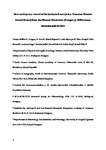New multiproxy record of the Jenkyns Event (also known as the Toarcian Oceanic Anoxic Event) from the Mecsek Mountains (Hungary): Differences, duration and drivers
| dc.contributor.author | Müller, T | |
| dc.contributor.author | Watanabe, Sayaka | |
| dc.contributor.author | Bajnai, D | |
| dc.contributor.author | Nyerges, A | |
| dc.contributor.author | Kesjár, D | |
| dc.contributor.author | Raucsik, B | |
| dc.contributor.author | Varga, A | |
| dc.contributor.author | Judik, K | |
| dc.contributor.author | Fekete, J | |
| dc.contributor.author | May, Z | |
| dc.contributor.author | Pálfy, J | |
| dc.date.accessioned | 2017-03-16T14:49:33Z | |
| dc.date.available | 2017-03-16T14:49:33Z | |
| dc.date.issued | 2017-01-07 | |
| dc.identifier.issn | 0037-0746 | |
| dc.identifier.issn | 1365-3091 | |
| dc.identifier.uri | http://hdl.handle.net/10026.1/8649 | |
| dc.description.abstract |
<jats:title>Abstract</jats:title><jats:p>The oceanic anoxic event in the Early Toarcian, often referred to as the ‘Torcian Oceanic Anoxic Event’, led to widespread deposition of organic‐rich black shales and geochemical anomalies in elemental distribution and multiple isotope systems in the Early Jurassic ocean. Best characterized by its hallmark carbon isotope anomaly, the event is widely regarded as a prime example of rapid greenhouse warming‐related changes in the Mesozoic Earth system. However, despite numerous studies, details of its forcing mechanisms, exact duration and the role of regional effects remain debated. This article presents new data (high‐resolution organic carbon isotope, calcareous nannofossil and elemental geochemical analyses) from the black shale‐bearing Lower Toarcian section in the Réka Valley, Hungary, with the aim of assessing any regional differences in the sedimentary and geochemical record and their bearing on the underlying oceanographic and climatic processes. Following a short segment with a positive trend at the base of the section, values of the carbon isotope data here are turning to a negative trend with a steep, stepwise drop in two negative shifts, reaching their minimum before a positive trend with oscillations characterizing the top part of the section examined. The shape of the curve and nannoplankton biostratigraphy (recognition of zones <jats:styled-content style="fixed-case">NJ</jats:styled-content>5b, <jats:styled-content style="fixed-case">NJ</jats:styled-content>6 and <jats:styled-content style="fixed-case">NJ</jats:styled-content>7) allow reliable correlation of these data with the global carbon isotope perturbation recorded elsewhere in the Early Toarcian. It is proposed here that it would be fitting to rename the Torcian Oceanic Anoxic Event as the ‘Jenkyns Event’, to honour the seminal contributions of Hugh Jenkyns. The cyclostratigraphic analysis in this study suggests that the duration of the negative isotope excursion at Réka Valley is 200 kyr, 350 kyr or 1 Myr, depending on which astronomical forcing parameter controls the most prominent cyclicity. Spectroscopic analyses suggest that the source of the organic matter, marine algae according to previous studies, did not change considerably during the main negative carbon isotope excursion. The variability observed in major element concentrations and enrichments relative to the average shale in the Réka Valley black shales can be regarded as mixtures of terrigenous aluminosilicates and calcium carbonate as two endmembers. Consequently, the terrigenous compositional endmember of the studied black shales consists of a mixture of an illitic/smectitic and a kaolinitic clay, which supports previous suggestions of increased weathering under extremely humid climate in the hinterland during the Jenkyns Event.</jats:p> | |
| dc.format.extent | 66-86 | |
| dc.language | en | |
| dc.language.iso | en | |
| dc.publisher | Wiley | |
| dc.subject | Carbon isotopes | |
| dc.subject | cyclostratigraphy | |
| dc.subject | Early Jurassic | |
| dc.subject | elemental geochemistry | |
| dc.subject | Fourier transform infrared spectroscopy | |
| dc.subject | nannoplankton biostratigraphy | |
| dc.subject | oceanic anoxic event | |
| dc.subject | Toarcian | |
| dc.title | New multiproxy record of the Jenkyns Event (also known as the Toarcian Oceanic Anoxic Event) from the Mecsek Mountains (Hungary): Differences, duration and drivers | |
| dc.type | journal-article | |
| dc.type | Journal Article | |
| plymouth.author-url | https://www.webofscience.com/api/gateway?GWVersion=2&SrcApp=PARTNER_APP&SrcAuth=LinksAMR&KeyUT=WOS:000393681500004&DestLinkType=FullRecord&DestApp=ALL_WOS&UsrCustomerID=11bb513d99f797142bcfeffcc58ea008 | |
| plymouth.issue | 1 | |
| plymouth.volume | 64 | |
| plymouth.publication-status | Published | |
| plymouth.journal | Sedimentology | |
| dc.identifier.doi | 10.1111/sed.12332 | |
| plymouth.organisational-group | /Plymouth | |
| plymouth.organisational-group | /Plymouth/Faculty of Science and Engineering | |
| plymouth.organisational-group | /Plymouth/Faculty of Science and Engineering/School of Geography, Earth and Environmental Sciences | |
| plymouth.organisational-group | /Plymouth/REF 2021 Researchers by UoA | |
| plymouth.organisational-group | /Plymouth/REF 2021 Researchers by UoA/UoA07 Earth Systems and Environmental Sciences | |
| plymouth.organisational-group | /Plymouth/Research Groups | |
| plymouth.organisational-group | /Plymouth/Research Groups/Marine Institute | |
| plymouth.organisational-group | /Plymouth/Users by role | |
| plymouth.organisational-group | /Plymouth/Users by role/Academics | |
| plymouth.organisational-group | /Plymouth/Users by role/Researchers in ResearchFish submission | |
| dcterms.dateAccepted | 2016-10-04 | |
| dc.rights.embargodate | 2017-12-22 | |
| dc.identifier.eissn | 1365-3091 | |
| dc.rights.embargoperiod | 12 months | |
| rioxxterms.versionofrecord | 10.1111/sed.12332 | |
| rioxxterms.licenseref.uri | http://www.rioxx.net/licenses/under-embargo-all-rights-reserved | |
| rioxxterms.licenseref.startdate | 2017-01-07 | |
| rioxxterms.type | Journal Article/Review |


